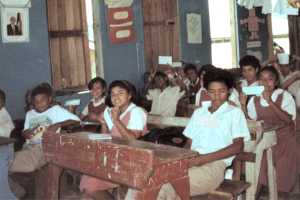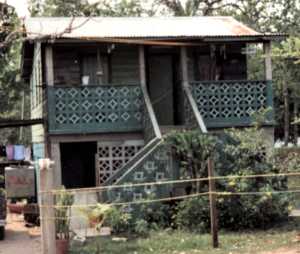Elanor Cronin
|
If
you have any comments, or if you
have further information please Click Here |
My job for the duration of my stay was to help the teachers in the local primary schools with religious studies though I was roped in to many other jobs as well. In order to reach some of these schools I had to avail of whatever local transport was available, usually battered old pickup trucks, which wound their way up rutted tracks, through rivers and around frightening bends to get to our destinations. Having survived those trips I usually spent the next quarter hour dusting my shaky self down! (Not for the faint hearted!)Elanor Cronin May 2003

School Class Room
One night in a friend's house I awoke to the sound of rustling. Gingerly I peeped out from under the sheet and spotted my white plastic bag moving across the floor at a terrific pace. No, it was not the wind, it was 4 cockroaches inside having a ball with my bag and its contents---Yuck!
In my spare time friends and myself usually took off to explore the fantastic countryside and seacoast. There are many opportunities for water sports on the coast--snorkelling, diving, and exploring the barrier reef .Up on the mountainous areas waterfalls abound. Unfortunately I could not swim at the time so I spent my time looking after my friend's belongings while they frolicked in the water! One day I got bored with this so I decided to get nearer my friends by clambering onto some boulders which surrounded a deep pool under the waterfall. I slipped and into the pool I went, head first. It seemed to take ages for one of my pals to reach me! I tell you I kept well away from deep water after that frightening episode.

A Dwelling House
Belize
Located on the Caribbean coast of Central America just south of the
Yucatan Peninsula is a new nation. Formerly called British Honduras,
but now known as Belize, this fledgling country acquired its independence
from Great Britain on September 21,1981. Today there exists a government
dedicated to democratic values and human rights that rests squarely
upon a foundation of a parliamentary system of governance, a legal system
based on English common law, and English as the official language of
the country. Geographically, Belize is an integral part of Central America,
but it has a strong affinity with Caribbean nations.
Geography
The Belizean landscape is wonderfully diverse with 192 miles of shoreline,
a superb baffler reef, 450 caves (pronounced keys), northern lowlands
and the Maya Mountains in the south (highest is at 3806 ft.) The climate
is subtropical with a mean annual temperature of 790F, and a trade wind
that provides cooling breezes most of the year. Rainfall varies between
50" in the north and 160" in the south; a distinct dry season
falls between February and May. The largest city is Belize City (pop.
50,000), a bustling seaport and airport gateway to the country, and
the former capital until a devastating hurricane in 1961 prompted the
removal of the seat of government to a more secure inland location.
Belmopan, the nation's capital was established in 1970.
History and Culture
Temples and archeological relics are found throughout Belize, evidence
of an extensive Maya civilization that endured for more than three thousand
years (2300 BC to 1600 AD). From an estimated peak of 3,500,000 at one
time, the Maya population was ravaged by war, disease and attrition;
it now numbers only a few thousand in Belize.
The first English arrivals were buccaneers who attacked Spanish ships
but later became harvesters of logwood-the source of an important red
dye. Beginning in 1720, African slaves were brought in as laborers to
harvest logwood, and later, mahogany. Despite frequent disputes between
Spain and England dating back to the 17th C., it wasn't until 1862 that
England claimed Belize as the colony of British Honduras. By this time,
slavery already had been abolished (1831), and Carib Indians and others
of African descent had come to Belize. Throughout the 19th and 20th
C., immigrants from many countries continued to arrive. The diverse
ethnic origins of the people are reflected in the multilingual Belizean
community where Creole, Spanish, Garifuna, Mopan Mayan, Kekchi Mayan,
Yucatec Mayan, low German, Chinese, Hindu, and of course, a unifying
English, are spoken.